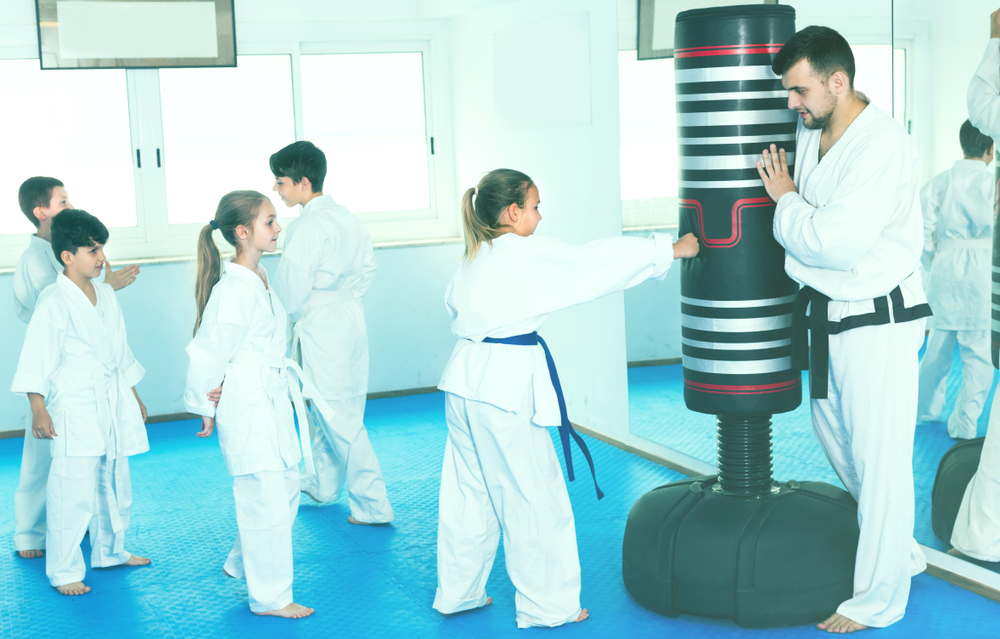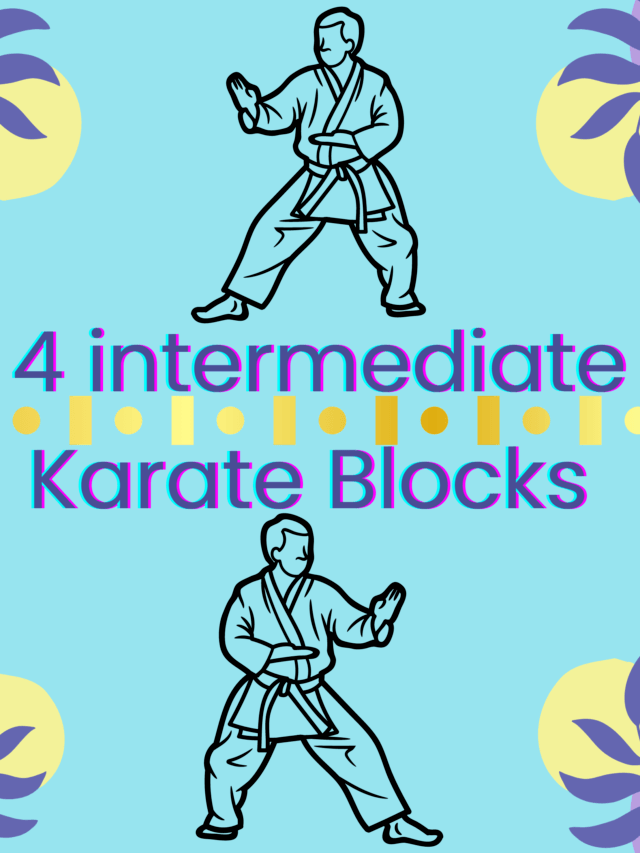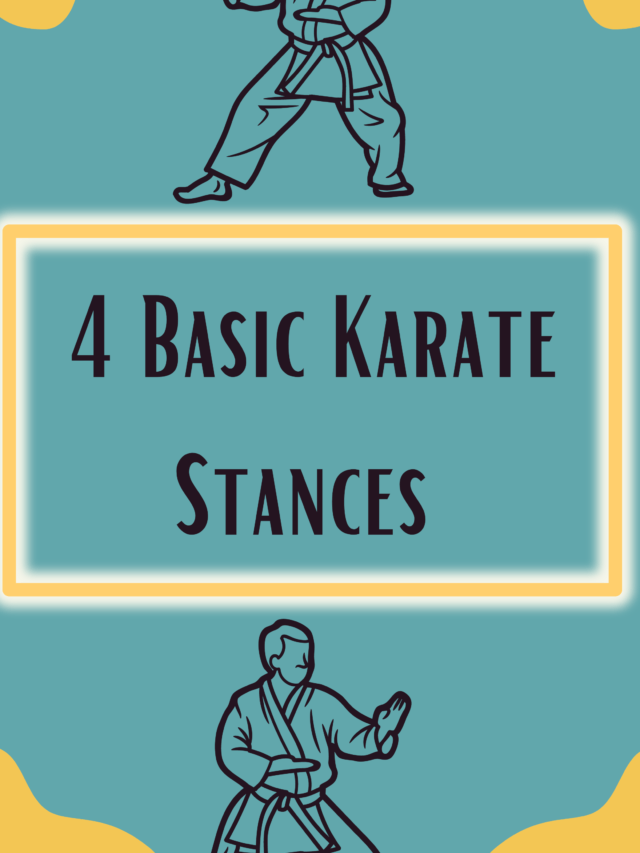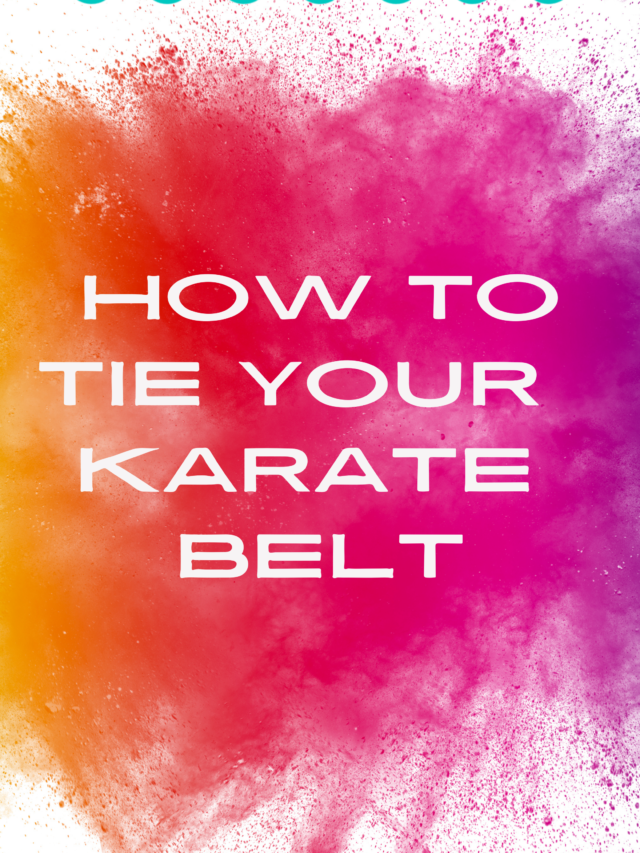Using a Punching Bag to Practice Karate: A
Beginner’s Guide to Safe Training at Home
A punching bag is one of the most useful tools for karate training at home. Regularly using a punching bag to practice karate at home helps you improve striking power, perfect your technique, and build endurance while working out in a controlled environment. Training with a punching bag lets you practice your strikes with full force without worrying about injuring a partner.

When you hit a heavy bag, you learn to maintain proper form while dealing with resistance. This makes your stances more stable and helps develop muscle memory for real-world applications. The feedback from striking the bag teaches you to generate power from your whole body, not just your arms.
Related: Best Punching Bag for Adults
Key Takeaways
- Regular bag work strengthens your strikes while improving technique and form
- Punching bags provide safe resistance training for building power and endurance
- Proper bag training develops muscle memory and practical striking skills
Benefits of Punching Bag Training for Karate Practitioners

Punching bag workouts offer amazing benefits for your karate training. Regular practice helps you become stronger, faster, and more precise with your strikes.
Enhancing Striking Power and Speed
Your striking power gets a huge boost when you train with a punching bag. The resistance of the bag helps you develop explosive force in your punches and kicks. Having a Punching Bag to Practice Karate at home helps make these practice sessions possible most days.
When you practice combinations on the bag, your muscles learn to fire faster. This builds the quick-twitch muscle fibers needed for lightning-fast strikes.
Using proper hip rotation while hitting the bag engages your whole body. This teaches you to generate power from the ground up through your legs, core, and into your strikes.
Improving Technique and Accuracy
A punching bag lets you perfect your striking form without worrying about hitting a moving target. You can take your time to focus on proper technique.
Training with specific targets on the bag helps improve your accuracy. Try marking different spots to aim for during your combinations.
Practice hitting the same spot repeatedly to develop muscle memory. This builds consistency in your strike placement.
Building Strength and Endurance
Regular bag work strengthens your muscles, tendons, and ligaments. Your arms, shoulders, core, and legs all get an excellent workout.
The continuous motion of striking the bag builds cardiovascular fitness. Try 3-minute rounds with 30-second breaks to improve your stamina.
Your punching endurance improves as you spend more time working the bag. This helps you maintain power throughout longer training sessions.
Developing Balance and Coordination
Moving around the bag while striking helps improve your footwork and balance. Practice stepping in and out while maintaining proper form.
Combining different strikes requires whole-body coordination. Start with simple combinations and gradually increase complexity as you improve.
Keep your guard up while striking to develop better defensive positioning. This builds muscle memory for protecting yourself during sparring.
Cultivating Precision and Control
Learning to control your power on the bag is essential. Use your Punching Bag to Practice Karate throwing strikes at different intensities – from light technical hits to full power.
Focus on making clean contact with the target area. A well-placed moderate strike is often more effective than a wild powerful one.
Work on retracting your strikes quickly after impact. This builds the control needed for traditional karate’s snap-back technique.
Related: Benefits of Karate Training Beyond Self-Defense
Fundamental Punching Bag Workouts

A punching bag is a great tool to build your karate skills and improve your striking power. Training with a punching bag helps develop muscle memory, strength, and proper technique.
Basic Karate Strikes on the Bag
Start with single strikes to perfect your form. Focus on straight punches (choku-zuki) aimed at the center of the bag.
Make sure your fist is properly aligned with your wrist and forearm to prevent injury. Keep your strikes sharp and quick, pulling back as fast as you punch forward.
Practice these basic strikes:
- Jab: Quick, straight punch with your lead hand
- Cross: Power punch with your rear hand
- Hook: Circular strike from the side
- Uppercut: Upward strike from below
Footwork and Movement Drills
Your footwork creates the foundation for powerful strikes. Move around the bag like you would move around an opponent.
Practice these movement patterns:
- Circle left and right around the bag
- Step in to strike, step back to defend
- Pivot on your front foot while striking
- Bounce lightly between strikes to stay mobile
Combination Techniques
Link your basic strikes together to create effective combinations. Start slowly to maintain proper form, then gradually increase your speed.
Try these basic combinations:
- Jab-cross
- Jab-cross-hook
- Double jab-cross
- Lead hook-cross-lead hook
Remember to reset your stance after each combination. Keep your guard up between strikes.
Timing and Rhythm Exercises
Use the bag’s movement to develop your timing. Let the bag swing naturally after your strikes.
Hit the bag as it moves toward you to practice defensive timing. Strike as it moves away to work on your chase-down techniques.
Create a steady rhythm with your combinations:
- Count out loud: “1-2-3” for three-strike combinations
- Use a timer: 30 seconds work, 30 seconds rest
- Alternate between fast and slow combinations
Advanced Karate Techniques with a Punching Bag

Training with a punching bag helps you master complex karate moves and build real fighting skills. Angle punching and advanced striking techniques transform your bag work into powerful martial arts practice.
Incorporating Katas into Bag Workouts
Break down your favorite kata sequences into smaller parts and practice them on the bag. Focus on hitting specific targets that match the kata’s striking points.
Start in your basic stance and move through each technique slowly at first. Pay attention to your form and foot placement.
Try performing complete kata sections while using the bag as your opponent. This helps you understand the practical applications of each movement.
Mix up your distance from the bag to practice both close-range and long-range techniques. Remember to maintain proper breathing throughout the sequence.
Practicing Kumite Skills Solo
Set up imaginary scenarios where the bag represents your sparring partner. Practice your blocking and counter-striking combinations.
Work on your timing by throwing quick combinations followed by defensive movements. Picture real kumite situations as you move around the bag.
Essential kumite drills:
- Counter-punch after blocking
- Multiple-strike combinations
- Side-stepping with strikes
- Distance control exercises
Utilizing Advanced Strikes and Stances
Train your body to strike effectively from different positions and stances. Practice transitioning between zenkutsu-dachi and other fighting stances while maintaining power.
Perfect your roundhouse kicks, hook punches, and spinning techniques. Always return to your ready position after each combination.
Key stance transitions:
- Forward stance to back stance
- Cat stance to forward stance
- Side stance to fighting position
Heavy Bag Drills for Power Development
Build striking power through focused heavy bag training. Start with single powerful strikes before moving to combinations.
Mix up your striking surfaces – use your knuckles, palm heel, and forearm strikes. Add kicks at different heights to develop full-body power.
Power development exercises:
- Full-power single strikes
- Three-strike power combinations
- Low, middle, and high-level kicks
- Explosive movement drills
Remember to maintain proper form even when hitting with maximum force. Take short breaks between power combinations to maintain technique quality.
Physical Conditioning Using a Punching Bag

Punching bag workouts strengthen your entire body while improving your cardiovascular fitness. Regular bag training builds power and endurance in ways that complement your karate practice.
Engaging Deep Muscles and Core Stability
Your core muscles activate with every strike on the bag. When you punch, kick, or strike, your abdominal muscles and lower back work together to maintain balance and generate power.
Training with a heavy bag engages muscles you might not normally use in basic karate drills. Your obliques, hip flexors, and deep stabilizing muscles all fire up to keep you centered.
To maximize core engagement, try these exercises:
- Alternate between high and low strikes
- Practice combinations while moving around the bag
- Add body rotation to your strikes
Tailoring Workouts for Muscle Groups
Different striking techniques target specific muscle groups. Your shoulders and chest get a workout from straight punches, while hooks engage your back and arms.
Full-body conditioning happens when you mix up your strikes. Kicks work your legs and glutes, while knee strikes build thigh strength.
Try this muscle-focused routine:
- 2 minutes of jabs for shoulder endurance
- 1 minute of hooks for back strength
- 2 minutes of kicks for leg power
Speed Bag Drills for Agility and Reaction Time
Speed bag work sharpens your hand-eye coordination and builds lightning-quick reflexes. Start slow and focus on rhythm before increasing your speed.
Keep your hands up at eye level and maintain a steady bounce pattern. Your timing will improve as you practice the basic rhythms.
Quick tips for speed bag success:
- Focus on wrist control
- Keep your elbows slightly bent
- Start with single hits before trying alternating patterns
- Practice short bursts of 30-60 seconds
Integrating Punching Bag Workouts in Martial Arts Training

Regular bag work strengthens your strikes while building muscle memory and core fighting skills. A good punching bag routine helps prepare you for real combat situations and develops your technique.
Transitioning from Karate Training to MMA
Starting MMA after karate training requires adapting your striking techniques to handle different fighting styles. Your karate strikes need modification to work against wrestlers and grapplers. Using your Punching Bag to Practice Karate at home can extend to MMA and other types, too.
Use the bag to practice combining karate kicks with boxing-style punches. This helps you develop a more rounded fighting approach.
Try these combinations on the bag:
- Front kick followed by a cross punch
- Roundhouse kick into hook punch
- Side kick transitioning to an uppercut
Adapting Bag Workouts for Sparring
Proper bag training helps you move smoothly from practice to sparring. Mix up your speed and power to match real fighting conditions.
Practice moving around the bag like you would an opponent. Step in to strike, then move out of range quickly.
Focus on these key elements:
- Distance management
- Footwork patterns
- Strike accuracy
- Defense after attacking
Enhancing Hand-Eye Coordination and Reflexes
Working with a moving target improves your reflexes and coordination. Push the bag and practice hitting it as it swings back.
Set up drills where you hit specific spots on the bag. This builds accuracy and helps you target weak points in real fights.
Mix up your combinations:
- Double jab to high kick
- Low kick to body punch
- Hook punch to spinning back kick
Keep your eyes focused on the target area before, during, and after each strike.
Equipment and Safety for Punching Bag Drills

The right gear and proper safety practices keep you safe while maximizing your karate training benefits. Good equipment choices and smart training habits help prevent injuries and improve your skills.
Selecting the Right Punching Bag
A standing bag like the Century Wavemaster XXL works great for home training since it doesn’t need hanging space. This type stays stable during practice and can handle powerful strikes.
Choose a bag weight that matches your size and strength. Heavier bags (70-100 pounds) give better resistance for adults, while lighter ones suit beginners and younger practitioners.
Consider the bag’s height too. Your bag should let you practice both high kicks and low strikes comfortably. Many standing bags are adjustable to match your height.
The filling material matters. Foam-filled bags provide good cushioning for beginners, while dense fabric filling offers more resistance for advanced training.
Importance of Protective Gear
Hand wraps protect your wrists and knuckles during bag training sessions. Wrap them snugly but not too tight.
Wear bag gloves or martial arts gloves to prevent skin damage and reduce impact shock. Make sure they fit well and have good padding.
Your feet need protection too. Wear proper martial arts shoes or go barefoot on a training mat for better grip and stability.
Maintaining Distance and Safety
Keep proper striking distance from the bag – about one arm’s length away. This helps you maintain good form and prevents awkward hits.
Check your training space. Clear at least 6 feet around the bag so you can move freely without hitting anything.
Always warm up before bag work. Start with light strikes and gradually increase power as your muscles warm up.
Inspect your bag regularly for tears or loose parts. A damaged bag can be unsafe and needs fixing before use.
Position your bag on a non-slip surface or secure mat to prevent movement during training.
Conclusion

Regular punching bag training will take your karate to the next level. The repetitive striking motions help build crucial muscle memory that transfers directly to your karate practice.
Your striking power and technique will improve dramatically with consistent bag work. The resistance of the bag helps you develop proper form while building strength.
Remember to focus on proper breathing during your bag workouts. This strengthens the connection between your breath and movements – a key aspect of effective karate striking.
Mix up your training with different combinations of punches and kicks. This keeps your workouts engaging while helping you master various striking techniques.
Start with short 15-minute sessions and gradually increase your training time. Your endurance will build naturally as you practice more frequently.
Most importantly, have fun with your bag training! The more you enjoy your practice sessions, the more likely you are to stick with them and see real progress in your karate skills.
Frequently Asked Questions

Training with a punching bag helps develop power, speed, and proper form in karate techniques. The right equipment and practice methods make a big difference in your results.
What are the benefits of using a punching bag for karate training?
Regular punching bag training improves your striking power and breathing control. Your speed and accuracy get better with each session.
You build muscle memory for proper technique while increasing stamina and endurance.
How can beginners effectively improve karate techniques on a punching bag to practice karate?
Start by warming up your muscles with light cardio exercises like jumping jacks or jogging. This prevents injury and prepares your body.
Wrap your hands properly to protect your wrists and knuckles during practice. Begin with basic strikes at moderate speed and power.
Focus on proper form before increasing your power and speed. Practice one technique at a time until it feels natural.
What type of punching bag is best suited for karate practice?
A medium-weight bag works well for practicing both speed and power techniques. The bag should swing slightly when hit but not too much.
Look for a bag that’s firm enough to provide resistance but has enough give to prevent injury.
Can you develop effective fighting skills by training with a punching bag alone?
Punching bag training improves your striking abilities but should not be your only training method. You need partner practice to develop timing, distance control, and defensive skills.
The bag helps perfect your techniques, but sparring with partners teaches real fighting applications.
What are some common mistakes to avoid when using a punching bag to practice karate at home?
Avoid hitting with incorrect form just to generate power. Poor technique can lead to injury and builds bad habits.
Don’t forget to move around the bag – standing still creates unrealistic training patterns.
Keep your guard up between strikes, just as you would in a real fight.
How often should one train with a punching bag to improve in karate?
Train with the bag 2-3 times per week, allowing rest days between sessions for muscle recovery.
Keep your training sessions to 20-30 minutes of focused practice. Quality matters more than quantity when developing proper technique.






